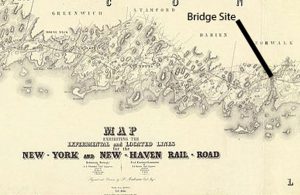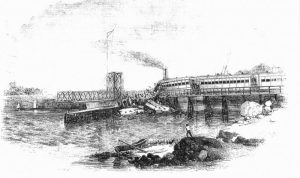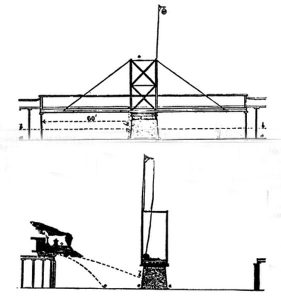This failure was not a structural failure but a failure of safe operational control of a wood and iron swing bridge built across the Norwalk River for the New York and New Haven Railroad. This line, as the name implies, was built to connect New York City with New Haven, Connecticut. The line was chartered in 1844, but construction did not start until 1847. The first train reached New Haven in January 1849. After leaving the New York and Harlem Extension at Williamsbridge, the line ran along the north shore of Long Island Sound and had to cross many streams and rivers draining from the mainland into the Sound. Some of these waterways were used for shipping, and the railroad had to provide for the boats using them.
In 1841, the New York and Harlem Railroad built a bridge over the Harlem River for its northern extension, marking the northern boundary of Manhattan Island. It was at Park Avenue (then called Fourth Avenue) with three fixed, wooden, 90-foot-long Town Truss covered spans. The remaining span was a 90-foot wooden swing span with a clearance of about 30 feet on each side of the pivot. The line then headed north to Albany through White Plains, ending at Chatham Four Corners where it linked up with the Albany and West Stockbridge (Boston and Albany) line to Albany. Its engineer was Alan Campbell and his assistant W. W. Evans.
It was decided to build swing bridges, much like the Harlem River span, that, when open, provided for shipping and when closed provided for rail traffic over the navigable rivers the line crossed. The longest of these was at Milford, where it crossed the Housatonic River. The bridge consisted of covered bridges on each end flanking a 134-foot wooden swing bridge. The total length of the bridge was 1,293 feet. The Norwalk Bridge was much shorter but had a similar swing span with open flanking wooden deck trusses. These were not the first wooden swing bridges but were early ones.

Bridge Site, approximately 50 miles from New York City. (Note some of the lines were added after the opening of the New York and New Haven line.)
The charter for the Norwalk Bridge required a horizontal clearance of 60 feet on both sides of the center swing pier. A tower was placed on the top of the trusses and chains dropped down to the trusses to support the cantilevered arms when the bridge was open. The method used to inform the locomotive engineer as to whether the span was open or closed was a red ball on a high post mounted on the bridge, so it was visible from a distance. “When this is displayed from the top of the pole, it signifies that all is right; but if the engineer can’t see it from a point about a quarter of a mile distant, where there is a sign, on which is written ‘Look out for the Draw’ with a hand pointing in the direction of the ball, he must stop.” This system worked well until May 6, 1853, when a train from New York City, bound for New Haven, ran through the signal and crashed into the Norwalk River with the locomotive, given its speed, actually crashing into the swing span pier 60 feet away.
Local newspapers covered the accident, in part, as follows:
“The 8 o’clock train for New York ran off the draw-bridge into the river near this place. One car was completely submerged, and two others completely demolished. There has been a terrible loss of life. The excitement is so great that it is impossible to get a list of the killed or injured. The engine went through first, followed by two passenger cars. The 4th passenger car split in two, one half of which was thrown into the river and the other half caught on the draw…The drawbridge was open, the steamboat Pacific having just passed through. The locomotive baggage car and two passenger cars plunged into the river, fifteen feet below the surface. Every person in the first two cars were either killed or severely injured…
It appears that the train left New York with about 200 passengers, a number of whom were bound to Bridgeport and other places in Connecticut…The train proceeded as usual until it reached South Norwalk, a distance of about 44 miles from New York. At this place is a bridge across the river, with a draw that swings to one side, leaving an open space for vessels to pass through. It appears that before the train reached Norwalk, the draw had been opened to allow the steamer Pacific to pass through. The steamer had cleared the bridge, but before the draw could be replaced, the train suddenly approached the bridge going at a rate of thirty miles an hour and perhaps faster. The water at this place, at high tide, is about nine feet deep, and the soft mud beneath it also quite deep.
On a high pole at the draw, a signal is placed, the position of which is, according to the rules of the road, to be arranged by the draw-tender, to indicate that the way is clear or otherwise, as the case may be. It is likewise customary for a man to wave a flag at or near the entrance of the bridge, in the village, to indicate to the engineer that there are no impediments in that immediate locality, as well as to keep people from the track. The engineer alleges that he looked out reasonably and that he not only saw the flag-waving at the point last mentioned but the signal on the pole at the draw so arranged as to indicate that all was right for the train to pass and that he accordingly went on.
The draw-tender, on the other hand, asserts that the reverse was the case – that he made the signal that the draw was open and the bridge, of course, impassable. The fault, therefore, lies between these two men. An investigation will determine upon which the dreadful responsibility must rest.
The draw being thus open, the advancing train leaped into the chasm. The engine went first and was buried in the mud so deep that at low water it was out of sight. The engineer, who says he had reversed his engine, saved himself by leaping off at the abutment of the bridge. The fireman saved himself in a similar manner. The baggage and smoking car in which there were a number of persons, fell upon the engine, followed by two passenger cars; a third passenger car fell halfway down, end broken in two, a portion of the passengers falling into the water, while others managed to save themselves, some of them being injured. The first passenger car contained some forty persons, many of whom were rescued through the roof. The baggage-car, when it struck the engine was much broken up, and the persons in it killed. One of the passenger cars was wholly submerged, and every person in it suppose to drowned.”
The engineer, Edward W. Tucker testified,
“I believe I was going at the rate of fifteen miles per hour past the Norwalk depot; I whistled for breaking up just west of the bridge over the road coming up to the depot; I am certain the ball was up; I cannot be deceived; I did not look through the window glass, but entirely out; I do not think I could have been mistaken anything for the signal; I can see the signal just before I got to the bridge; I am certain I saw the signal; I am very careful…I sounded the whistle the moment I saw the end of the draw; the brakes were not applied for if they had been, I think the train might have stopped before going off the bridge…”
The bridge keeper, William Harford, testified,
“As near as I can remember, it was fifteen minutes from the time I started the draw to close it before the train went over… I then lowered the ball and laid it on the bridge. I kept the bridge down a few minutes and listened if I could hear the train coming… I only heard the whistle as the train came around the curve; the whistle was blown twice; I heard no bell…that is my opinion as near as I can guess the length of time; I have not seen the engineer, and I don’t want to see him hardly.
Other persons testified that the ball was in a down position indicating the bridge was open. A total of 46 people were killed and 85 injured. A coroner’s inquest found, in part:
The immediate cause of this disaster was the negligence and recklessness of the said engineer.
1st – In running around the curve at a rate not less, certainly, than twenty miles per hour; when under the circumstances should have been half that.
2nd – In not discovering that the ball was down immediately after emerging from the cut.
3rd – In not looking for the ball at the highway crossing east of the depot.
4th – In relying, as he says he did, upon the flags of the switch-tenders, when he well knew that they were not in sight of the draw, and had nothing to do with it.
5th – In not running even slower than usual when the track was wet and slippery.
In addition to all this, he well knew that the draw was required to be very frequently opened. In not discovering that the ball was down, we think he was guilty of gross negligence. In running around the curve at this rapid rate, and under such circumstances, we think him guilty of the most criminal recklessness.
At the same time, we do not think the entire responsibility of this disaster rests upon him. As we have before observed, the rules of the company do not make it the duty of the conductor to observe the signals, nor are we prepared to say that they should.”
Appleton’s Magazine had a lengthy article on the disaster, writing:
“There were three other causes conspiring with this temporary carelessness, or the result would never have been experienced. First, the curve in the road and a number of intervening objects shut the signal out from view during a considerable portion of the immediate approach to the bridge. Second, the color of the signal had faded by exposure from a bright vermillion to a reddish-brown. The third, and principal, is the fact that, at the distance of some half a mile, the point where the eye of the engineer first meets this signal of safety, it is exhibited not standing out against the sky but against a distant wood, any dark spot in which might, in the temporary stupid condition supposed, be taken for the signal. This is the theory we have formed, and confidently believe in, at the present moment. The only look at the signal was made mechanically, on first emerging from the bridge; at this distance, some dark spot in the background was made to answer the purpose, and the fated train swept on till near the bridge before the absence of the accustomed signal flashed on his lethargic brain.”
The coroner’s report was carried in full in many newspapers later in May 1853 and was signed by all 12 members of the Jury. Tucker and Comstock, the conductor, were charged with manslaughter, but both were acquitted. Death claims amounted to about $290,000, which almost bankrupted the railroad. The state legislature passed a law that required all trains to come to a complete stop before proceeding across any swing span, agreed to by Appleton’s. In the early years of the development of the American Railroad, this was the worst disaster on record and, as is often the case where there is loss of life, Legislatures overreact as they did here. Making the train stop before proceeding, while safe, requires a longer time for the train to get from point A to point B thus negating the economic advantage of the railroad, its speed.■


